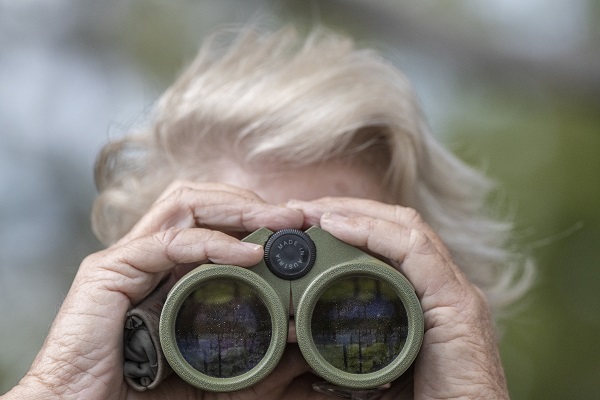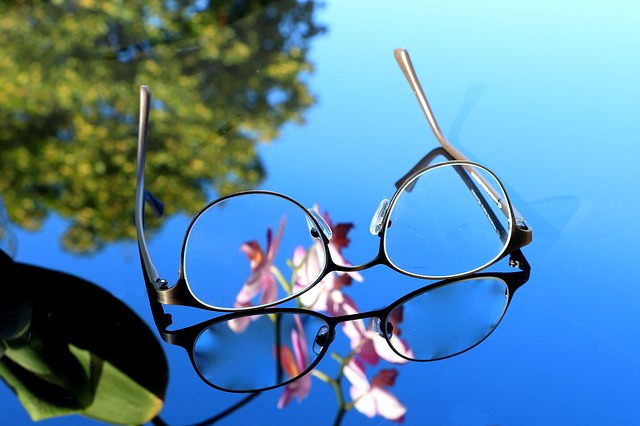Editor’s Note: This article, by our Wildlife curator Dan Brooks, PhD., was co-authored by HMNS Accessibility Programs Manager Matti Wallin and Marcia Moore, OD, FCOVD, ABO Diplomate of Bellaire Family Eye Care.
Nearly everyone enjoys wildlife, but sometimes it can be challenging to get good views when you’re out in nature! As February is Low Vision Awareness Month, it only makes sense that your local science museum wildlife curator weighs in on this challenge, along with guest bloggers Marcia Moore and Matti Wallin. We will discuss potential accommodations and resources for enjoying wildlife if you have visual impairments, including low vision.

If you are someone who has visual impairments less extreme than low vision (legally or completely blind), corrective lenses adjust your vision to make it easier to see. However, when your optometrist is prescribing lenses for you there is a very fine-tuned threshold between compensation for near- vs far-sighted vision. If you wish to enhance your far-sighted vision, it will diminish near-sighted vision, and vice-versa. Your optometrist will strive to find the ‘best fit’ between this fine-tuned interactions between near- and far-sighted vision. Along these lines, one solution is having a dedicated pair of far-sighted contact lenses or glasses just for birdwatching or wildlife viewing. It will be more difficult to read your GPS device to find your destination with your stronger far-sighted lenses, but setting the navigation to audio mode will help with that. Another solution is to just not wear your lenses in the field, and just let your binoculars adjust the proper compensation for your vision. This of course will depend how challenged you are at seeing the ground without any corrective lenses. Logs, hills, holes, etc can be serious hazards without your corrective lenses!
Sometimes you might not be completely confident with what species you are seeing, especially with vision loss or low vision. Databases such as eBird and iNaturalist can help suggest potential species in your region by providing lists of what can typically be expected at the site you are visiting. Find these resources and more via the Houston Urban Wildlife Project website.

So for example, you might see a swallow zoom by, but not sure what species it was. As a hypothetical example, eBird might show that both Barn and Cave Swallows are in the region, and you saw that it didn’t have a forked tail, which is characteristic of Barn Swallow. With that knowledge you can assume that what you saw was probably a Cave Swallow since the others with straight tails (Tree, Cliff, etc) are not expected at the site you are visiting.
Another way to enjoy wildlife, especially birds, is Birding by ear. I do a lot of this for my work in the field with point counts – that is, recording how many individuals of different species you see and/or hear from several fixed (stationary) positions. One thing I’ve learned as my ability to ‘Bird by ear’ has improved over the years is to always trust your gut instinct! More often than not you will only hear a given species perform its call or song once. Initially questioning my sanity at hearing a Bald Eagle vocalize one time in an area I wouldn’t expect them, or a Great-horned Owl call one time during morning (instead of night when they are typically active), I’m rewarded after traveling to the area where I faintly heard the single doubtful call, only to find them! Always trust your initial gut reaction…
If you are stumped by what species you are hearing, the most popular App to help identify bird calls is perhaps the Merlin App developed by Cornell Lab of Ornithology. Using your phone, just record the bird song or call you heard and plug in into Merlin; it will tell you what species you are hearing, often correctly!

When people have visual systems that struggle to function or see, it is important to isolate the visual tasks at hand. For people with visual impairments less extreme than low vision or blindness, having a dedicated pair of glasses and/or contacts for wildlife viewing can make a huge difference! For people who have low vision or are blind, check out additional ideas and resources on Birdability for Birders who are Blind or have Low Vision.
Read more from Dr. Dan Brooks:
A dispersed flock of angels, a rare woodpecker and a local cast of celebs from the past…






